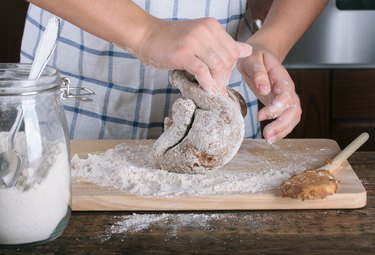
Vital wheat gluten and gluten flour, also sometimes simply called wheat gluten, refer to the same thing: an extraction of the protein in wheat flour with no starch. Vital wheat gluten is sold as a loose "flour" in grocery stores and health food stores, where, when mixed with water and spices, it makes seitan, a vegetarian "meat" that is rich in protein. Vital wheat gluten can also be added to regular flours to increase the content, making high-gluten flour, which is ideal for baking chewier breads. Homemade seitan will have less added fat and fillers than commercial seitan, which also frequently includes extra sodium.
Nutritional Profile
Video of the Day
One-half cup of vital wheat gluten, or gluten flour, weighs roughly 50 grams and makes 3 ounces of seitan when you mix it with 2/3 cup of water. Seitan is traditionally used in Asian cooking as a meat substitute, although it is also eaten by vegetarians and those who are looking for a meat replacement that has the texture and taste of meat. A 3-ounce serving of seitan has 185 calories, less than 1 gram of fat, almost 38 grams of protein and only 14 milligrams of sodium. Commercially produced seitan, sometimes called as wheat gluten, may contain more fat and sodium and less protein as producers use filler and salt to make their seitan. Seitan made only from vital wheat gluten and water will be naturally low in salt and fat.
Video of the Day
As a Protein
Seitan serves as a source of protein in your diet, and including it in a dish will help you get to the U.S. Department of Agriculture's recommended 5 to 6 1/2 ounces of protein foods each day. As it is very high in protein, it makes up 68 percent to 83 percent of the total recommended amount of protein, as stated by the Centers for Disease Control and Prevention. While seitan has traditionally been made into fake "meats" in Asian cooking -- flavored and shaped to look like foods such as chicken or shrimp -- much of the ready-to-eat seitan you find in grocery stores emphasizes the nonmeat aspect of the food, seasoning it with mushrooms and keeping it in plain-looking pieces.
Using Seitan
While seitan is naturally low in fat and sodium, ready-to-eat seitan, including seitan that is cooked to resemble meats, can be high in added fat and sodium. Some preparations also deep-fry seitan to make a crispy outer "skin" that mimics fried chicken or other meats. The American Heart Association recommends that no more than 25 percent to 35 percent of your dietary intake come from fats. To further keep your seitan healthy, use mushrooms, dried spices and herbs to flavor your seitan rather than salt, as it can boost your sodium intake. A single teaspoon of salt has 2,000 milligrams of sodium, which is almost all of the recommended upper intake of 2,300 milligrams per day. For people who are over 51, of African-American descent or have a history of heart disease or kidney disease, the recommended upper intake drops to 1,500 milligrams per day.
Flours High in Gluten
Vital wheat gluten can also be added to flours to raise their gluten content, although some flours retain more of their natural gluten during processing, as they provide greater structure and texture to baked goods. Bread flour contains between 14 percent to 16 percent gluten, compared to all-purpose flour, which has 10 percent to 12 percent. You can add 1 to 2 tablespoons of vital wheat gluten to 1 cup of all purpose flour to increase the gluten content if you don't have any bread flour on hand. The extra protein in the flour gives more structure and shape to breads, which is especially prized in artisanal baking, in which loaf pans are not commonly used.
- Exploratorium: Goodness Gracious! Great Balls of Gluten
- The Kitchn: Vital Wheat Gluten - What Is It and When Should It Be Used?
- USDA National Nutrient Database: Vital Wheat Gluten
- Centers for Disease Control and Prevention: Protein
- ChooseMyPlate.gov: How Much Food From the Protein Foods Group Is Needed Daily?
- American Heart Association: Know Your Fats
- Colorado State University: Sodium and the Diet
- The Kitchn: What's the Difference? Cake Flour, Pastry Flour, All-Purpose Flour and Bread Flour